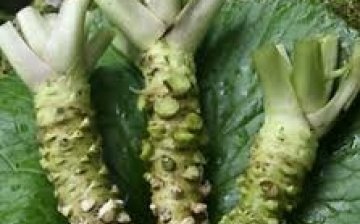Japanese horseradish
Japanese horseradish or wasabi is a type of herbaceous perennial plant in the Eutrem genus of the Cabbage family. The rhizome of the wasabi plant is used as a condiment in Japanese cuisine. Wasabi is a plant with a leafy, simple stem, rising or creeping. Plant height reaches 45 centimeters. The leaves of the plant are round, heart-shaped, they have a long petiole and a crenate edge. The leaves at the bottom of the plant are larger. The flowers are white, small, have bracts, the flowers are collected in the apical raceme. The plant has ovoid petals with an elongated marigold. Japanese horseradish blooms in April and May. The fruit is a pod with eight seeds.
Japanese horseradish can only be found in Japan. Real wasabi is obtained from the root of a plant that grows under certain conditions - in running water and at a temperature of 12-17 degrees.
Wasabi root taste is not evenly distributed. The upper half of the root is usually sharper than the lower half. Japanese chefs usually grate only the amount of wasabi they need for a given dish. The rest of the root is tightly wrapped in a film in order to preserve its smell and taste. In this form, Japanese horseradish can be stored without loss of valuable qualities for about one month.
Wasabi flowers and stems are also used in Japanese cuisine. They are used to make tempura.
Wasabi also has such a beneficial quality as disinfection. This property is of certain importance when eating raw seafood - squid, fish, shrimp.



